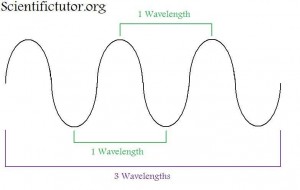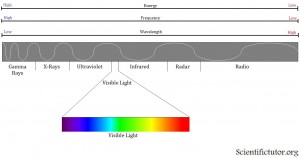Scientific Tutor
Chem – Light
What is light?
The technical name for light is electromagnetic radiation. Light is made up of tiny particles (spheres) called photons and is a form of energy. The sensation you get of feeling warmth on your skin when you walk outside on a sunny day is actually billions and billions of photon particles smashing into your skin and the reaction of your nerves sensing them. So, whenever there is light around, you are being bombarded by countless numbers of tiny particles. It is as if a thousand or more people all threw a ball at you at once and all those balls hit you. This is the easy part about light to understand. However, light also behaves in a second way. Unlike a ball or bullet, the photon of light does not travel in a straight line. The photon (particle) of light travels in a wave. That means it travels up and down slightly as it travels in the forward direction. This is kind of like a stone skipping across water except a stone will eventually sink, whereas the photon never stops the up and down motion. These two components, or behaviors of light,are what scientists call the wave particle duality. That is light acts both like a wave and a particle. A picture of the light wave is shown below. In science, anything that is called a wave or has wave properties travels in this way.
What is the difference between different colors of light?
The most important feature of the wave is what they call the wavelength. A wavelength is the measurement of how long the wave is from crest to crest (highest point to the next highest point). You can also make the wavelength measurement at any repeating set of points like trough to trough (lowest point to lowest point). The difference in color of light that we see is the difference in how long or short those wavelengths are. If we look at a representation of the different colors that we see (the visible spectrum), we observe that the colors run from red to purple (violet) like in the electromagnetic spectrum picture below. Thereare also types of electromagnetic radiation that we, as humans, cannot see. Past the red side of the spectrum this includes things like radio waves and infrared. Past the purple side of the spectrum this includes things like ultraviolet and x-rays.
What is the relationship between the wavelength and the color of light?
Notice in the picture above that the red side of the spectrum has longer wavelengths than the purple side. Therefore, we can use color of light that we can see as a relative indicator of wavelength. Toward the RED side of the electromagnetic spectrum the WAVELENGTH IS LONGER. Toward the PURPLE side of the electromagnetic spectrum the WAVELENGTH IS SHORTER.
What is the frequency?
VIDEO Explanation of frequency.
Frequency is the other way to measure waves. In common terms it is how many times the wave goes up and down. In scientific terms, frequency is how many waves can you observe passing in a particular time period. The units of frequency are 1 / seconds or Hertz (Hz). A good way to think about frequency is to imagine you are standing at the edge of a body of water like a lake or ocean. Water waves behave the same laws as light waves so we can use water waves to test measurements and theories. Let’s bring a stopwatch and count how many waves reach our feet in one minute, then we can say something about the frequency of those waves. If a lot of waves hit your feet in one minute, like 10 waves, then the frequency of that particular set of waves is high. If only a handful of waves hit your feet in one minute, like 3 waves, then the frequency of that particular set of waves is low.
What is the relationship between frequency and the color of light?
We can look back to the electromagnetic spectrum and also see the relationship between frequency and color of light. Toward the RED side of the electromagnetic spectrum the FREQUENCY IS LOW. Toward the PURPLE side of the electromagnetic spectrum the FREQUENCY IS HIGH.
PRACTICE PROBLEMS: Given information about the wavelength or frequency, state whether the color of the light is more toward the red side of the spectrum or the purple side of the spectrum.
| Wave has a short wavelength | Purple side |
| Wave has a low frequency | Red side |


